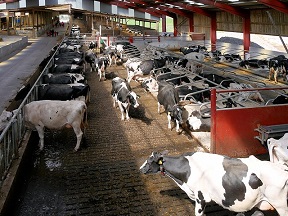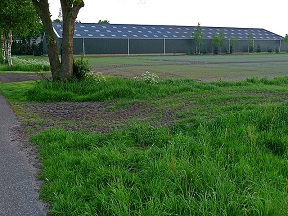Animal husbandry has a major ammonia problem; in the Netherlands, anyway. Cows are held in barns in which urine and faeces are collected together. This is a perfect mix for a hefty ammonia emission. To the detriment of surrounding nature; if cattle are free-ranging, this doesn’t happen. The Dutch government intends to buy out high-emission farmers next to natural areas. But in doing so, we will make things difficult for ourselves. We should curb ammonia emissions.
This is the first of two articles on ammonia emissions by modern cattle farming. The second one was published on October 1, 2023.

In a thorough piece (in Dutch), Herman A. de Boer argues that we should tackle this problem at its source: by developing low-emission stable systems. The problem isn’t typically Dutch. It manifests itself at all locations where cattle are held in ‘modern’ stables. Who knows? The Dutch might do well abroad, exporting smart low-emission stable systems, he says. Herman A. de Boer is professor emeritus in Medical Biotechnology at Leiden University (the Netherlands). And founder of some innovative companies: Pharming (that developed Herman the Bull), Prosensa (exon skipping technology for treatment of Duchenne muscular dystrophy), and Mastivax (substitutes for antibiotics in dairy cattle) (link in Dutch).
Environmental problems
The cow itself strictly separates faeces and urine. Even as they walk freely around. But as soon as faeces and urine come together, the urea in the urine will be processed to ammonia. According to the reaction: (H2N)2CO + H2O à 2 NH3 + CO2. Responsible for this process are urease bacteria in the faeces. The process starts almost immediately. Ultimately, the only solution for preventing it is the separation of faeces and urine. Just like in nature. But there are almost no stable floor or manure treatment systems that fulfil this condition.
One of the most immediate consequences is the ‘acid rain’. A phenomenon that surfaced in Europe in the eighties, at that time primarily because of high emissions of sulphur and nitrogen oxides. We now more or less keep those emissions in check; what bothers us now is ammonia emissions. For in the air, ammonia will be transformed to a mixture of nitrogen oxides – that turn the rain into diluted nitric acid. To the detriment of plants and animals, for it reduces the bounty of nature; and also bad for mankind. In order to prevent these chemical consequences of the manure problem, we should prevent ammonia being emitted from cattle breeding. And yes, we can do that.

Urine and faeces, put together
Animal husbandry is applied biochemistry, De Boer writes. Cattle farmers are practising biochemists. Anything happening within the cow is biochemistry; pre-digestion; milk and meat production; all these are the final result of a huge number of biochemical processes, conducted in harmony. A state of affairs that predates us by millions of years. But from the sixties onwards, things went wrong. We mixed faeces and urine – whereas nature separated the two meticulously. It resulted in huge NH3 emissions. This insight directly suggests the nature of possible solutions. But even then, it appears not to be easy to find solutions that follow natural laws AND modern economy’s requirements.
Ammonia emissions also damage human health. Particularly if combined with NOx and SO2 emissions, the latter primarily by industry. If ammonia gets into contact with these substances, it will form small particles that will penetrate deep into the lungs and cause health problems. Even causing 250,000 deaths yearly in Europe. We might ban animal farms from industrial areas. But it might even better to prevent ammonia emissions.
Main problem: ammonia emissions
Present Dutch policies don’t offer an adequate solution to dairy farmers. Yes, farms located close to natural areas scan be sold to the authorities. But that doesn’t solve the heart of the problem, the ammonia emissions. About 80% of NH3 emissions worldwide originate in agriculture; be it fertilizer use or faeces and urine production by cattle. The fertilizer contribution is appreciable, but here we leave it out of consideration. Other meat sectors (goat, pig or calve keeping) result in problems not unlike those in the dairy sector. Other countries have problems comparable to that of the Dutch; but less pressing, as the Netherlands host most cattle per hectare.
A large portion of nitrogen containing fertilizer is in use for growing grass. But the cow is an inefficient processor of that grass. Much of what goes in at the front, will leave again at the back. Just a quarter will end up in the protein. We humans function in the same way. If we take the entire nitrogen cycle, we humans use just 10% of the nitrogen in fertilizer; the remainder ends up in the environment.
A solution
If we should like to solve this problem, says De Boer, we need to separate urine and faeces. The urine fraction is quite valuable because of the amount of urea that it contains – but only if we recover it in its pure form. A cow will produce about 100 kg of urea per annum through its urine. A farm with 200 cows will therefore produce ca. 20 tons of urea per annum. If the farmer recovers that amount, he needs to use 10 tons less of nitrogen in fertilizer. He will save the adjacent natural area and on top of that, he will burden less the climate (fort fertilizer production emits major amounts of CO2).
But as things go at the moment, most urea will end up in the air as ammonia (NH3). Because the cow’s faeces contain an enzyme that quickly decomposes urea: urease. This process is very fast and starts as soon as both fractions come into contact with each other. Unfortunately, this mixture will take place in almost all techniques presented to farmers to prevent this problem. I.e., it will also happen in so-called low-emission stables with perforated floors; or with rubber floors with dung separation. Therefore, often claims of emission reductions are not true. Skids that move the faeces generally exacerbate the problem, says De Boer. Whatever we do with the mixture will not have much effect. Acidify the mixture? No great results. On top of that: new environmental problems. Dilution? No effect. Disinfection? Will exacerbate the problem.
And yet, there are solutions. We will look into them in a second article.
Interesting? Then also read:
Perspectives for agriculture – the new farming
Towards new agricultural practices
The disruption of the cow
